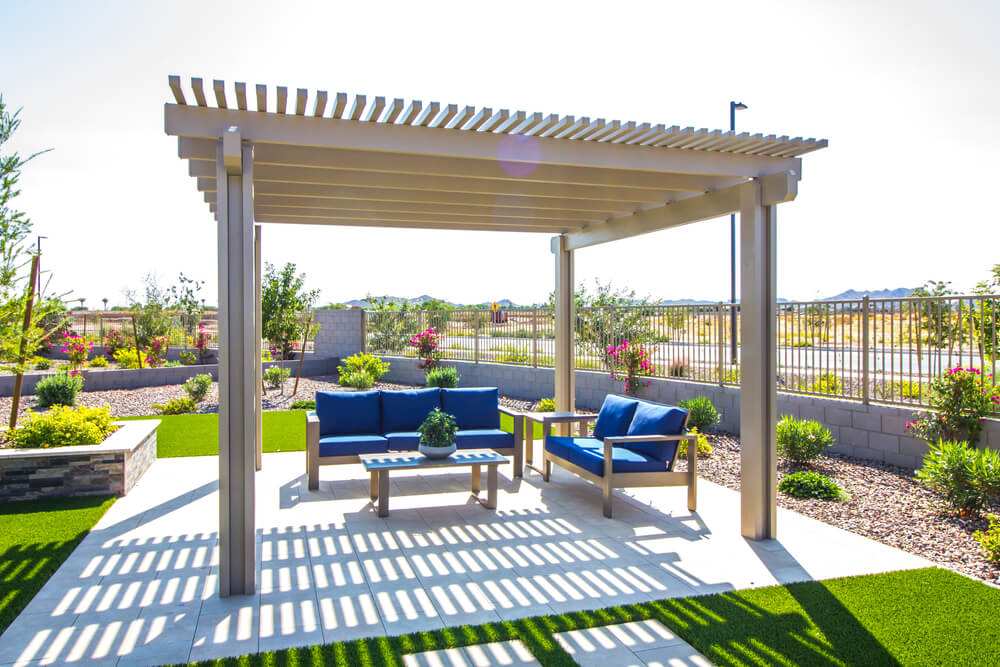The Complete Pergola Buying Guide
Some 3000 years ago, the wealthiest and most important members of Egyptian society first used pergolas. The Romans continued popularizing them to break up large spaces and provide much-needed shade while outdoors. Today, the popularity of the pergola has not diminished. Pergolas dominate the $1.3 billion outdoor living structure market.
Their appeal is multi-dimensional. Pergolas come in different shapes and sizes and can be a great addition to your home and its landscaping. But as with any home purchase, you must know all the facts before deciding.
That’s where Rollac’s pergola buying guide comes in handy. It is a comprehensive overview of this popular outdoor structure designed to answer all your questions about buying a pergola.

What is a Pergola?
A pergola buying guide would only be complete with a definition of this structure. A pergola is not a canopy, Camargue, gazebo, or pavilion. It is a permanent outdoor structure with columns or posts supporting an open roof of rafters and beams. The pergola often acts as a framework for flowering plants or climbing vines.
Traditional pergolas do not have roofs. Instead, they typically had slates that let in a certain amount of light. The most popular pergola materials include wood, steel, vinyl, and plastic.
Advantages of Pergolas in Outdoor Spaces
One of the most significant benefits of having a pergola is how it can transform your outdoor living space. Other advantages that are often mentioned in a pergola buying guide include the following:
- Cooler temperatures on hot days
- Neutralizing harmful UV rays
- Much more privacy
- Innovative use of your outdoor living areas
- Easily installed almost anywhere, providing style and elegance for your home or business.
Types and Styles of Pergolas
There is such a wide variety of different types of pergolas that there is undoubtedly one to suit your taste and style. The following are the most common types of pergolas.
1. Freestanding Pergolas
These stand separate from your home, usually near your pool or a garden. A freestanding pergola can also create many unique living spaces within a yard.
2. Attached Pergolas
This pergola is attached directly to your home’s wall. It is often used to cover decks or patios. Attached pergolas are popular with homeowners who want their outdoor living areas to be an extension of their home’s interior.
3. Arched Pergolas
This pergola will give your home a very elegant appearance. Unlike some pergolas that are made with flat roofs, an arched pergola brings elegance and charm to its setting.
4. Louvered Pergolas
A pergola that can be opened and closed for more or less sunlight is called a louvered pergola. Similar to a retractable awning, a louvered pergola can be manual or automatic. Instead of using traditional slats, louvers or large pergola shutters replace rafters.
5. Awning Pergolas
This pergola is attached to a wall and does not comprise support posts or columns. An awning pergola can be installed over windows or doors for a pleasant look and more shade. Like the others featured in this pergola buying guide, an awning version can be personalized using vines that climb up the structure for more shade and a unique look.
What’s the Cost of Building a Pergola?
‘How much does it cost to build a pergola?’ is the most common question we receive at Rollac. It’s important to understand that no two pergolas cost the same. The cost of a pergola depends on several factors, and those can dramatically influence the final price tag.
On average, the cost to build a 10ft pergola ranges from $2,400 to $8,960. The average price is $5,000.
What Affects the Cost of a Pergola?
1. Type of Construction
Perhaps the most significant factor affecting pergola prices is whether it’s built by a professional or comes ready-made. Materials and labor costs range from $16,000 to $25,000 if the pergola is customized, including using exotic woods (e.g., teak). Customized pergolas require professionals to design and erect the structure, and they need more time to construct and install.
2. Materials
Another factor affecting the cost of buying a pergola is the types of pergola materials used. Choosing wood, vinyl, fiberglass, or aluminum can dramatically affect the price.
Wood is the most popular material for this type of outdoor covering. Its appeal is its natural look and usually suits any design or budget.
Cedar and redwood are the most fashionable wood varieties, averaging $25-$35 and $40-50 per square foot, respectively. The most expensive natural material is teak, which costs $45-$100 per square foot.
Then there is fiberglass, which averages $50-$70 per square foot. It is the most expensive material when buying a pergola. Yet its appeal is that it’s lightweight, strong, and easy to install accessories, including lights or overhead fans.
Other factors that affect pergola costs include size, whether it is freestanding or attached to your home, stains, sealants, or paints needed for the wood, and the caliber of designer necessary to turn your pergola into a reality.
Is it Cheaper to Buy or Build a Pergola?
A ready-made pergola is usually your best bet when budget is a concern. Prefabricated pergolas come in various sizes, materials, colors, and styles.
Though these DIY pergola kits may not give homeowners the unique look that perfectly complements their outdoor space, they are certainly easier on the wallet. If you build one from a prefabricated package, your pergola costs should be between $800 and $3,500.
Does Building a Pergola Require a Permit?
A permit may or may not be needed to install a pergola. Always check local regulations in your city and county and with your HOA (Homeowner’s Association) for additional guidelines about installing outdoor structures.
Where Can Pergolas be Installed?
Modern pergolas can be installed almost anywhere. Many people love having a structure such as this over a deck or patio. It can turn the outdoor area into an extension of the home’s interior. Chairs, tables, a grill, and other items can be added to create an actual living area.
Pergolas are also great for providing shade to a pool, jacuzzi, or spa. You can also include screens and a patio cover to get more privacy, making this a low-maintenance option that creates even more beauty.
Finally, pergolas are always popular in gardens or walkways that deserve more emphasis. In addition to their outstanding architectural elements, climbing vines or colorful plants can be added for extra emphasis.
How to Choose The Right Pergola
A comprehensive pergola buying guide should explain the factors to consider when choosing the right shade solution for your home, including the following.
1. Choose Your Material
Wood is the most common material used to build pergolas. Factor in your area’s climate, insects that may pose a problem, how much maintenance and care you can give your pergola, your project’s budget, and the overall cost of building a pergola when selecting materials.
2. Know Your Frost Level
Know your area’s frost depth, which is the level at which the ground freezes. This is crucial since support beams need to be installed below this level. If they are not, they will crack and be displaced from their holes, ruining your pergola.
3. Style and Shape
Square and rectangular pergolas are the most versatile. However, depending on your needs and preferences, you can also choose from pergola shapes such as hexagonal or circular.
4. Coverage and Shade
Consider how much coverage and shade you want from your pergola. Panels provide coverage you can easily control, while a thatched or aluminum roof will do if you know you always wish to complete coverage.
5. Are Hurricanes a Factor?
Always decide if you will need a hurricane-proof pergola for your home. If so, a metal pergola may be best. Metal pergolas can withstand harsh weather conditions and are easily dismantled before a storm.
Can Pergola Installation be a DIY Project?
Yes. You can build your pergola from the ground up or make it easier using a prefabricated pergola kit. If you’re uncomfortable doing this as a DIY project, hire a professional builder to bring your pergola to life.
A Wonderful Addition
Whether you want a new way to protect outdoor furniture on your patio, give yourself more privacy when swimming, or create an exquisite outdoor space to entertain guests, a Rollac pergola can make your visions a reality.
To learn more about the many benefits our pergolas offer, contact us today at Rollac.
